- Quick Read
- Deep Read ( 10 Min. )
Monitor Daily Podcast
- Follow us:
- Apple Podcasts
- Spotify
- RSS Feed
- Download
TODAY’S INTRO
We love
 Mark Sappenfield
Mark Sappenfield
An indelible image from the protests has been police kneeling with protesters. A significant development has been a rise in calls to “defund the police” – with Minneapolis, the city where George Floyd was killed by police – considering just that. Underlying both of these developments is a more fundamental question: What is our view of power and its influence on American policing?
In a recent interview for Vox, Black author Ta-Nehisi Coates suggests nonviolence is the gift of protesters to those in authority, showing a higher and more humane mode of action. “The people who are called on to be nonviolent are the people with the ability to do the least amount of damage; whereas, we don’t call upon those who have the most power and actually can do the most damage.”
What would nonviolent policing look like? How would a country that embraced the power and principles of nonviolence act? Those answers are neither obvious nor easy. But the deeper demand of today is an expanded sense of love for all – a truer “us.”
Writes Professor Ibram X. Kendi on Twitter: “I love. And because I love I resist. There have been many theories on what’s fueling the growing demonstrations against racism all over America, from small towns to large cities. Let me offer another one: Love. We love.”
Share this article
Link copied.

Help fund Monitor journalism for $11/ month
Already a subscriber? Login

Monitor journalism changes lives because we open that too-small box that most people think they live in. We believe news can and should expand a sense of identity and possibility beyond narrow conventional expectations.
Our work isn't possible without your support.
A deeper look
‘Say Their Names’: Why the George Floyd protests resonate globally
The killing of George Floyd has sparked protests outside the U.S., and not just about American police injustice. Those abroad are raising their voices about racist policing at home.

-
Colette Davidson Correspondent
-
Whitney Eulich Correspondent
-
Ryan Lenora Brown Staff writer
The killing of George Floyd beneath the knee of a white police officer in Minnesota has not just fundamentally changed the American conversation on race. Protests have spilled to several countries – and a gaze that has often been fixated on the deeply entrenched racism and violence in the U.S. has shifted domestically.
In recent days, thousands of citizens have protested, from the German capital of Berlin to Barrie, Ontario, from Montreal to Mexico City. While many march in rage at the death of Mr. Floyd, protesters also honor those victims who have died in the custody of their own law enforcement.
In Paris, nearly 20,000 people protested in the streets over the death of Adama Traoré, a 24-year-old Malian Frenchman who died in 2016 after police pinned him down and suffocated him following a chase. In Toronto, in the days after the death of Mr. Floyd, a Black Canadian, Regis Korchinski-Paquet, died in a fall from her high-rise apartment balcony in Toronto in the presence of police. The tragedy has led to a week of peaceful protest urging Canada to face up to its own racism.
And protesters and activists say they believe today’s anger and anguish, which has rarely garnered such international attention, could be a pivotal moment to renew proposals and policies against racial discrimination worldwide.
‘Say Their Names’: Why the George Floyd protests resonate globally
Adama Traoré.
Amine Bentounsi.
Regis Korchinski-Paquet.
Chantel Moore.
Giovanni López.
Collins Khosa.
They are names that may have remained unknown beyond the circle of family who bury them. Now their memories are being invoked in marches, written in marker on cardboard signs, and commemorated across social media as victims of police brutality against racial and ethnic minorities that spans well beyond the United States.
The killing of George Floyd beneath the knee of a white police officer in Minnesota has not just fundamentally changed the American conversation on race. Protests have spilled to several countries – and a gaze that has often been fixated on the deeply entrenched racism and violence in the U.S. has shifted domestically.
In recent days, thousands of citizens have protested, from the German capital of Berlin to Barrie, Ontario, from Montreal to Mexico City. While many march in rage at the death of Mr. Floyd, protesters also honor those victims who have died in the custody of their own law enforcement.
In Paris, nearly 20,000 people protested in the streets over the death of Adama Traoré, a 24-year-old Malian-Frenchman who died in 2016 after police pinned him down and suffocated him following a chase that ensued after an ID check. “We live with these tragedies, and each subsequent tragedy brings us back to our own,” says Amal Bentounsi, who lost her own brother in 2012 after he was shot in the back by police. “George Floyd’s death resurrected awareness about what is going on in France.”
In Toronto, in the days after video captured Derek Chauvin putting weight on Mr. Floyd’s neck for nearly nine minutes, a Black Canadian, Regis Korchinski-Paquet, fell to her death from her high-rise apartment balcony in Toronto in the presence of police. Though the details are unclear, the tragedy has led to a week of peaceful protest urging Canada to face up to its own racism. “This is happening all over the world, it’s not just a single situation in the U.S.,” says Keenan McFoy, a university student in criminology, at one of several marches held in Toronto over the weekend.
And protesters and activists say they believe today’s anger and anguish, which has rarely garnered such international attention, could be a pivotal moment to renew proposals and policies – from mandating body cameras and collecting better race-based data to more politically divisive calls like “defunding” police – against the deafening silence of resignation and denial about racial discrimination worldwide.
***
For Ms. Bentounsi in France, decades of discrimination made her brother Amine, a young man of North African descent with multiple theft and drug charges, a perfect candidate for police violence in a country that has long been taught to fear those like him.
She is not naive about her brother. At the age of 13, Mr. Bentounsi became the youngest French person to be imprisoned at the time, after setting a garbage can on fire outside a preschool. He spent the next decade in and out of jail. Then in 2012, after going on the run during a prison leave, police were called on him in a Paris suburb.
When they approached him, he threw a fake grenade and police shot him as he ran. He died at age 29.
Ms. Bentounsi says it’s almost as if her brother knew his fate before everyone else. His favorite song had been “Hexagone,” a 1975 French song that called France a police state. When Ms. Bentounsi poked fun at him for humming the old-fashioned tune, her brother scoffed back, “You don’t understand a thing.”
Just how often minorities like him are killed at the hands of police is a narrative without data, since the government does not track race-based killings and censuses on race or ethnicity are banned in France. Instead anecdotes mount, often explosively.
In 2005, when minority youths were chased by police and two electrocuted after hiding in a power substation in the outskirts of Paris, it led to three weeks of rioting. France was roiled anew in debates about the marginalization of ethnic minorities after the terrorist attacks in 2015 in Paris. But little has moved to fully address the issue of inclusion in France and less to tackle race head-on.
Nacira Guénif-Souilamas, a socio-anthropologist at the University of Paris 8, says the concept of the “other” traces back to France’s foundation as a colonial power and slave state. “This idea of the ‘other’ was always entrenched in how the French state thought of itself and how it exerted power,” she says.
Even today there has been an unwillingness for the government to recognize race as a central issue of poverty, crime, or discriminating police surveillance. After the June 2 Paris protest, Christophe Castaner, France’s minister of the Interior, told the nation there was no structural racism within the French police. After a second week of protests exploded across the nation, he reiterated that the police as a system was not racist, but said that there would be zero tolerance for officers who are.
Sebastian Roché, a sociologist of police and security at the French National Center for Scientific Research, says a growing alliance of intellectuals, leftists, and minority voices are challenging the traditional narrative. “There is a divorce between civil society and the state,” he says.
That introspection is not limited to France. Over the weekend, as thousands took the streets in peaceful marches across the United Kingdom, signs bearing Mr. Floyd’s name and Black Lives Matter shared space with those linking U.S. racism to British colonialism. In Bristol, protesters tore down a controversial statue of a slave trader.
Ms. Bentounsi says now is the time to push changes that are garnering more mainstream attention beyond devastated families or activists. Her nonprofit has created an app called UVP (Urgence Violences Policieres, or Police Violence Emergency). Because the use of body cameras by French police has been spotty and victims complain they destroy phones or erase images taken by bystanders, the app would allow users to quickly upload images to the nonprofit to be reviewed by a lawyer to give society a broader view of discrimination at play.
“We as a nonprofit are deeply hurt by the comments being made [by the government or media] about this racist crime taking place in the U.S. when no one is even talking about what is happening in France.”
***
In Canada, that kind of denial has been easier to promulgate with its position next to the U.S., where racial divides often rage to the surface. Instead Canada promotes its tolerance and diversity as part of its national ethos, particularly in its biggest city, Toronto, which is among the world’s most multiethnic. But that’s not the Canada that many indigenous and non-white Canadians experience.
Race-based data is not systematically collected in Canada either. But the Ontario Human Rights Commission published a landmark report in 2018 that showed between 2013 and 2017, a Black person in Toronto was nearly 20 times more likely than a white person to be involved in a fatal shooting by the Toronto Police Service, despite Black people making up only 8.8% of Toronto’s population.
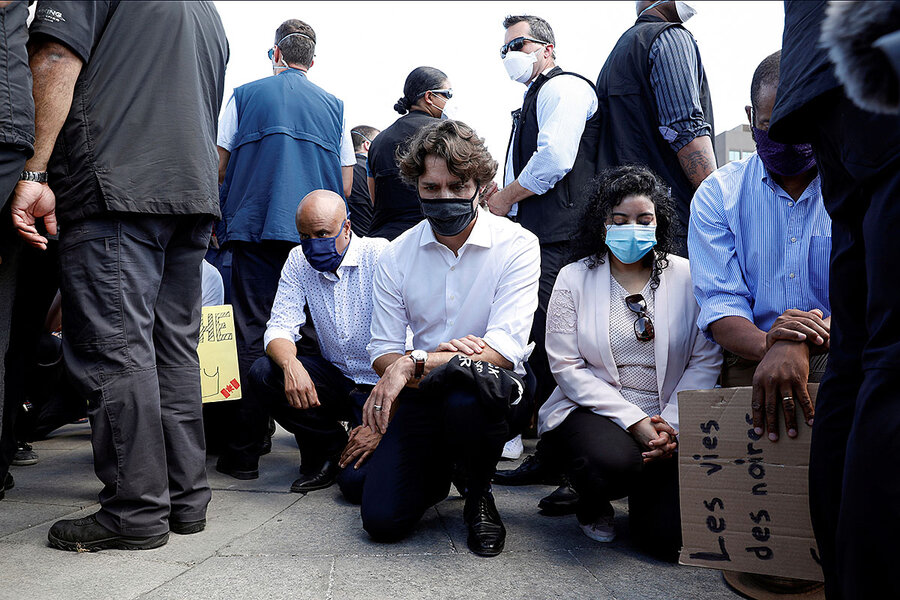
As protests mounted over the week eulogizing Ms. Korchinski-Paquet, Chantel Moore, a young First Nations woman living in New Brunswick, was shot by a police officer during a call to check on her well-being that is now under investigation. Denise O’Neil Green, vice president of equity and community inclusion at Ryerson University in Toronto, says both cases have amplified the movement here, shattering the myth that racism doesn’t exist in Canada.
“What I see here as a pivotal movement, not only in Canada but around the world, is that people see themselves reflected in this experience in terms of interactions with the police,” she says. “This moment I really see as a catalyst for people to begin to speak their own truths and be critical of their institutions of policing and how to begin to disrupt that.”
It is a demand that is harder for leaders to ignore, as they field questions about requiring law enforcement to wear body cameras or reprioritizing funds from police to more robust social services. Last week the premiers of Quebec and Ontario denied systematic racism in their provinces, but under fire, Ontario Premier Doug Ford the next day walked back his statement.
Prime Minister Justin Trudeau took a knee at a protest in Ottawa in a sign of solidarity with protests in the Canadian capital. Toronto Police Chief Mark Saunders did so on Friday, and then later announced he is resigning this summer. Blasted as hollow publicity stunts by some critics, other protesters say it’s a sign that white privilege can no longer remain unquestioned. Clive McFoy, a hospital worker originally from Jamaica who was at the Toronto protest Friday, says he brought his two college-aged sons to bear witness to what could become a moment of “social change.”
Says his son Keenan: “When I saw the video of Floyd, I was so angered. But I didn’t want to sit there and be angry,” he says. “Seeing everything going on in the U.S. inspired me to want to do more. They are doing a bunch of stuff, why can’t we?”
***
The pandemic has ground the world to a halt. But it has put racial and class divides in sharp relief as poor minorities have been among the worst hit by COVID-19. That has lent more urgency to the anti-racism movement that is growing internationally – and given police more room to abuse powers, the very tactics for which protesters are demanding justice.
In the Mexican state of Jalisco, a young bricklayer named Giovanni López was detained by police last month for reportedly not wearing a face mask. He died after being taken into police custody. Over the past several days, angry, mostly young protesters have taken to the streets calling for an end to police brutality – a movement that was inspired by protests in the U.S. “If this news about Giovanni came out before [the George Floyd demonstrations] we probably wouldn’t have seen protests like this,” says María Inclán, a professor of political science at Mexico’s Center for Research and Teaching in Economics (CIDE) who focuses on social movements.
Race has not risen to the fore at protests in Mexico, where the history of the Mexican Revolution defines all Mexicans as mestizo, a mix of indigenous and Spanish blood, history, and culture. That narrative has long served to shut down conversations on race, even though darker-skinned Mexicans live a daily reality of discrimination.
“It is based on this argument that we are all equal,” says Valeria Angola, a member of the Afro-Mexican women’s collective Flores de Jamaica, which was founded to draw attention to the realities of being Black in Mexico. “But when you start to see who can access higher education or who can stay home or maintain a healthy distance during COVID-19, you realize in reality we are not equal.”
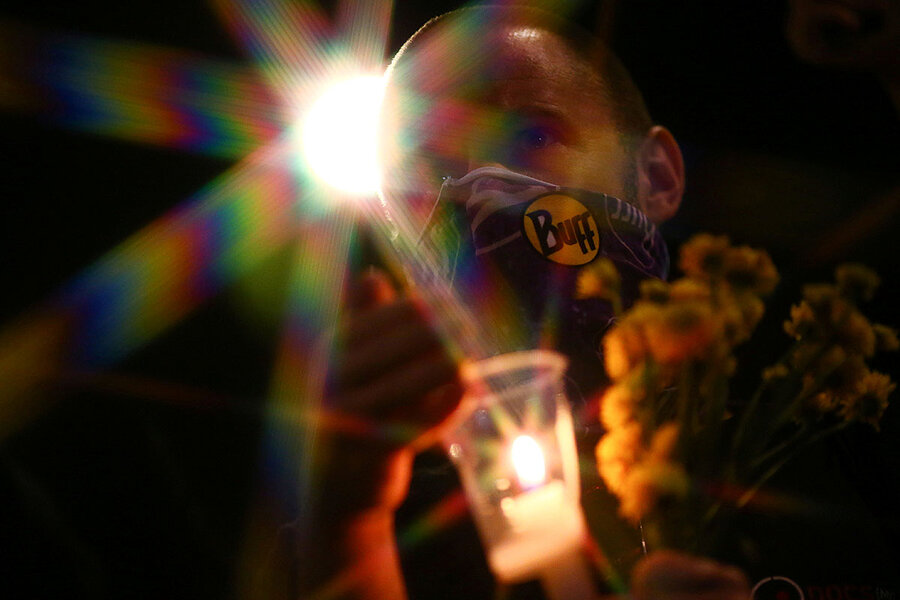
A 2017 study published by Vanderbilt University’s Latin American Public Opinion Project found that “race is the single most important determinant of a Mexican citizen’s economic and educational attainment.” There’s a 45% gap in educational achievement between the darkest- and lightest-skinned Mexicans, the report found.
Report co-author Daniel Zizumbo says that because racism doesn’t exist in the national discourse, there are few studies on how racial bias plays out in policing or the judicial system. “We know this [bias] happens in the U.S., but in Mexico everyone assumes that we are colorblind. And because of that, we don’t have the chance to study it profoundly or implement policies that cite these biases.”
But now some Mexicans are calling for recognition of how much discrimination penetrates every facet of Mexican society, often with life-or-death stakes. Celebrities like actor Gael García Bernal and director Guillermo del Toro have spoken out about police brutality and the need for justice in Mr. López’s death. And individuals are trying to start conversations among their peers about the role of race in everyday life.
“Are you against racism in the U.S.… ? But in Mexico you say chacha [infantilizing slang for a housekeeper], indio [Indian], you make fun of [Oscar-nominated indigenous actress] Yalitzia [Aparicio] ...” wrote Ana Carlota Hervel, a lawyer in Mexico City, on her Facebook page.
“I have seen a lot of reactions here in Mexico [to the George Floyd protests in the US] that have surprised me,” says Ms. Angola. “This wave of indignation has been ignited.”
***
In South Africa, some activists have drawn strength from the movement growing around the globe.
When a man named Collins Khosa was killed by soldiers enforcing South Africa’s strict lockdown in April, there was an initial outcry. But it grew in strength and intensity after protests began in the U.S. following the killing of Mr. Floyd.
Young Black activists like Tumi Moloto, who is referred to as they, said they saw it as their responsibility to speak out against both Mr. Khosa’s killing and that of Mr. Floyd. Such international solidarity in the anti-apartheid movement was a crucial part of the fight, they say. “So we as South Africans need to see the struggle of Black people anywhere as the struggle of Black people everywhere.”
“The silver lining here is that what’s happening in the U.S. right now is showing us that a different world is possible. The conversations are beginning in the U.S. and South Africa [around police brutality],” they add. “Maybe they are the start of that different world we’ve been dreaming of.”
But for many that global fight begins with the fight for justice for each individual life, including Mr. Traoré, Mr. Bentounsi, Ms. Korchinski-Paquet, Ms. Moore, Mr. López, and Mr. Khosa. It’s a movement that has also grown from Minneapolis, where Mr. Floyd was killed, across the world. Activists in the American city have erected memorials shaped like tombstones across a green lawn, listing 100 African Americans who have died in the U.S. at the hands of police. In white block letters laid out in the grass, three words that have become a rallying cry now around the world, spell clearly: “Say Their Names.”
Editor’s note: This story has been updated to correct names and misspellings.

Deepwater Horizon: What we learned from worst oil spill ever
Thousands of experts studied oil spills and the Gulf of Mexico after Deepwater Horizon, the worst oil spill in history. That research is changing our understanding of such events.
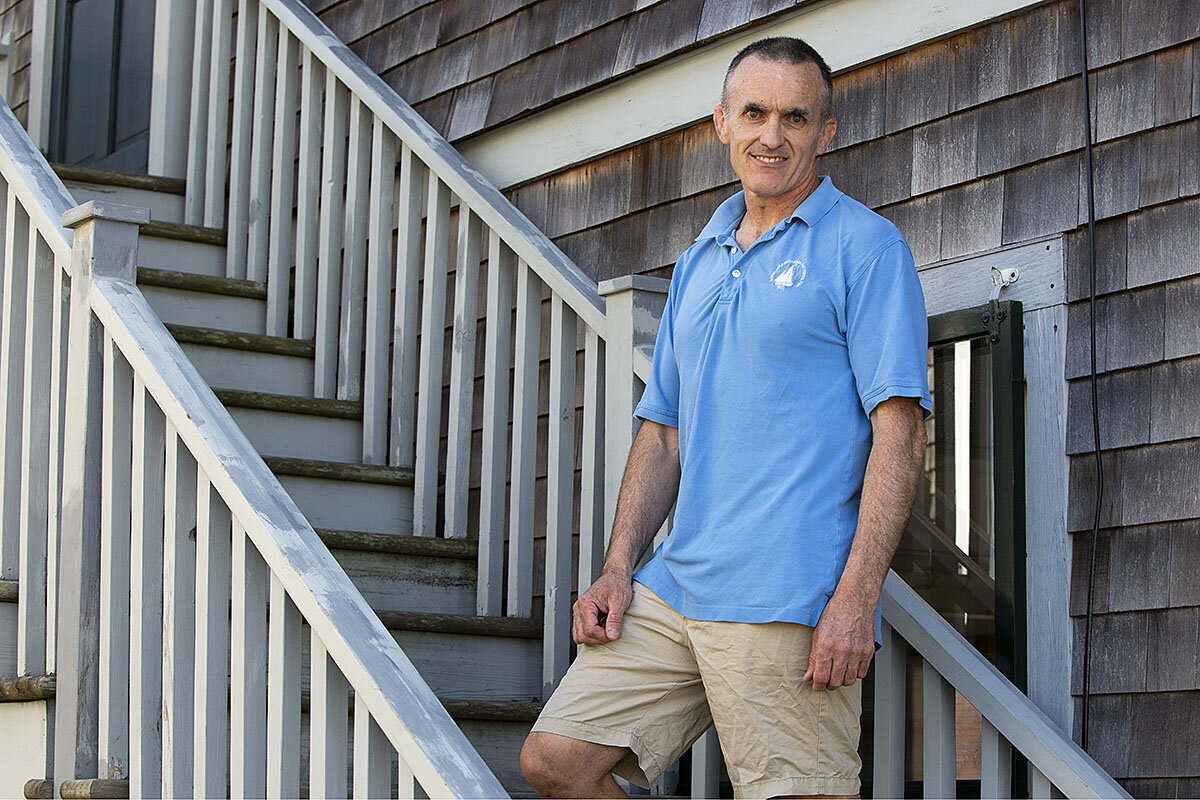
- Quick Read
- Deep Read ( 5 Min. )
-
By Doug Struck Correspondent
It’s been a decade since the Deepwater Horizon drilling rig exploded off the coast of Louisiana. The largest ever marine oil spill killed 11 workers, injured 17 more, and poisoned thousands of square miles of water, air, beach, and marsh. Millions of animals died, and vital seafood and tourist industries were paralyzed.
While paying homage to the tragedy, scientists say the spill spawned a bonus: 10 years of intense research into oil spills and the Gulf of Mexico. Progress came via 1,400 published papers and half a billion dollars spent in funding, yet important questions remain. Researcher Christopher Reddy says the initial fieldwork should have included better planning to test and measure different approaches. Dispersants – chemicals used to prevent oil slicks – were injected underwater for the first time in 2010. But “we don’t have a consensus agreement about using dispersants on the bottom of the seafloor,” Dr. Reddy notes.
And while tougher safety practices and federal enforcement followed the spill, many of those advances have been rolled back.
Nancy Kinner, at the University of New Hampshire, points to a better understanding as a result of the research response to a disaster. “Adversity often gives us the best opportunity to become better,” she says.
Deepwater Horizon: What we learned from worst oil spill ever
Christopher Reddy had had it. The scientist had been studying oil spills for 15 years, but he was frustrated that his lab’s work was ignored by both government and industry. He figured it was time do something else.
A few weeks later, the Deepwater Horizon oil rig exploded.
“I got a call from a government scientist I knew very well. He said we need someone to go down and do fieldwork. I told him, ‘Nah, I quit science. I’m done.’”
The Deepwater Horizon explosion, on April 20, 2010, soon became the world’s biggest maritime oil leak, and Dr. Reddy, a senior scientist at Woods Hole Oceanographic Institution, soon found himself headed to Louisiana.
“The guy’s boss, who I was really good friends with, called me several days later, and he said ‘Listen you got to get over this whole ‘quitting this oil spill thing.’ Here’s the deal: You are going to get involved, you will do some good science, it will change your career, and you will make a huge impact,’” Dr. Reddy recalls with a chuckle. “He was absolutely right.”
The eruption at the wellhead a mile underneath the BP Deepwater Horizon drilling rig 10 years ago was a catastrophic disaster: It killed 11 oil workers, injured 17 more, and poisoned thousands of square miles of water, air, beach, and marsh. Millions of marine animals and seabirds died, and the Gulf’s vital seafood and tourist industries were paralyzed, bankrupting workers and businesses. The well jetted more than 200 million gallons of oil and gas into the water for 87 days, until it was finally capped July 15, 2010.
The harm from the accident, which dwarfed the 1989 Exxon Valdez spill of 11 million gallons, was indisputable. But scientists, while paying homage to the tragedy, say the spill spawned a bonus: 10 years of intense research into the Gulf of Mexico and oil spills.
“It’s been hugely successful,” says Rita Colwell, an acclaimed microbiologist who headed the National Science Foundation and agreed to take a 10-year post to direct the Gulf of Mexico Research Initiative (GoMRI), funded with $500 million from BP.

The initiative lists assistance from 4,400 researchers, involvement of more than 380 other scientific groups, production of more than 3,000 sets of data, and 1,400 published papers, not including research done outside of GoMRI.
“We’ve just been hugely productive. And we’ve worked really hard to keep the public informed,” Dr. Colwell says by telephone from her home near Washington. The program is wrapping up its work with a “holistic” overview of the research, she says.
The conclusions of the science are not unequivocal. The role of dispersants, which were injected in the oil plume underwater for the first time, still remains contentious. But researchers did find that natural microbes ate a lot more of the oil than expected. They also found there’s a narrow window before sunlight converts liquid oil on the surface to a sticky sludge that does not respond to dispersants.
They found that many species recovered faster than predicted, while other species were devastated, some for generations. And the researchers established a foundation of data about the ecology of the Gulf of Mexico that had not existed before.
Science often focuses on “the smallest molecule or the smallest microorganism,” Dr. Colwell says. The Deepwater research, she adds, involved many in the Gulf community and points to the need to take a broader view that includes impacts on people.
“It’s not enough to study the physics, or the dispersion of oil or the chemistry, without understanding the social impacts, which were really extensive in the Gulf,” Dr. Colwell says.
Many others agree.
“There was a lot of science done,” says Dr. Reddy, who played a key role in the post-spill efforts at the Gulf. “Ten years later we spent millions and millions of dollars to study the spill. We know a lot about this spill.”
But, he says, like many scientists, he is not completely satisfied. He says the initial field work should have included better planning to test and measure different approaches.
“We don’t have a consensus agreement about using dispersants on the bottom of the seafloor,” he notes. With another spill, “we have unfinished business. There’s going to be pushback because they didn’t have the data.”

The BP spill also carried consequences for government, though there is much less consensus on the outcome. Every oil spill is an assault on the environment, but each provides lessons. After an oil well blowout near Santa Barbara, California, in 1969, public outrage helped spawn the first Earth Day and a quick succession of far-reaching federal environmental laws. The Valdez oil spill in 1989 led to the banning of single-hull tankers and navigation safeguards that significantly reduced spills from cargo ships. A May 29 spill of 20,000 metric tons from a diesel storage tank in the Arctic Circle is still challenging efforts to contain it.
The Deepwater Horizon spill, too, brought cries for industry and government action. A bipartisan commission appointed by President Barack Obama called for tougher safety practices, more and better blowout preventers, and independence of the federal agency overseeing drilling safety enforcement.
Many of those governmental advances have been rolled back under the Trump administration, which has waged a relentless assault on environmental safety and health regulations that stretch back to Richard Nixon’s presidency.
Donald Boesch, a member of the presidential commission, says the government has lost credibility with its own inspectors and the public, as President Donald Trump and his appointees emphasize a desire to “produce more oil and get off the backs of industry,” with safety a seeming afterthought.
There was progress, he says. “We are in a better position to be able to tap a well, cap a blowout, much more quickly than we were,” Dr. Boesch says. And he acknowledges the voluminous scientific research that followed the Deepwater event.
“But then I would add to that, so what?” Dr. Boesch says from his home in Annapolis, Maryland. “We have learned a lot about what the oil does in the environment. But I don’t think that science has really put us in a better position to respond to another oil spill like that.” Industry would use much the same cleanup techniques for future spills, he says, and “it would still be pretty ineffective.”
Nancy Kinner, co-director of the Coastal Response Research Center at the University of New Hampshire, argues that the research gives oil spill responders more tools of knowledge. “Now we have a better picture of the whole system, and we understand that if you push here you have a response there.”
“I don’t ever want to say that the Deepwater spill was a good thing. It was a horrible, horrible thing in so many ways,” Dr. Kinner says from her home in Georgetown, Maine. “What I prefer to say is adversity often gives us the best opportunity to become better.”

Summer school 2020: Hints for how the fall will go?
After a major disruption to learning, what should summer school look like? Worcester, Massachusetts, offers a picture of how districts are trying to make the most of the moment.

- Quick Read
- Deep Read ( 7 Min. )
Jonathan Echevarria, a single father in Worcester, Massachusetts, says it’s been a challenge to oversee schoolwork for his 6-year-old son during the pandemic, but he’s learned a lot about Jaevell and his education that he didn’t know before. He may even continue with online summer school. “I see his real potential and personality now,” this father says.
Educators in Worcester and across the United States are considering how best to use the summer to help students make up learning lost to coronavirus disruption. This year, ideas for June, July, and August – traditionally a time for helping struggling students catch up and staving off learning gaps – include using the time as a trial run for more remote and in-person learning in the fall or creating programs that blend academics with play and social-emotional support.
Some schools will end up with few or no summer offerings, facing limited budgets and challenges reaching students. Still, educators say summer school could have a larger-than-usual impact this year, if districts are able to plan and fund it.
“The key is figuring out what each student needs,” says Douglas Harris, a professor at Tulane University, “and getting them what they need to get back on track.”
Summer school 2020: Hints for how the fall will go?
Amanda Sonnenberg feels exhausted from overseeing the remote learning of her four kids. As the school year draws to a close, she’s looking forward to a break and outside play. But, for the first time, she’s also considering summer school for her children.
“Summer is summer,” she says, as she wears a color-coordinated mask and Red Sox T-shirt in line outside Gates Lane School of International Studies to pick up meals distributed by Worcester Public Schools. “But given the circumstances that we just had COVID-19 ... I would consider [summer school] just to help them be prepared for next year.”
Educators here, in New England’s second-largest city, and across the United States are considering how best to use the summer to help students make up for lost learning after the most disruptive spring for K-12 education in recent history. This year, ideas for June, July, and August – traditionally a time for helping struggling students catch up and staving off learning gaps – include using the time as a trial run for more remote and in-person learning in the fall or creating programs that blend academics with play and social-emotional support.
Editor’s note: As a public service, all our coronavirus coverage is free. No paywall.
Some schools will end up with few or no summer offerings, facing limited budgets and challenges reaching students. Still, educators say summer school could have a larger-than-usual impact this year, if districts are able to plan and fund it.
“To the extent that [summer school] can be done well and in ways that could reach students who’ve been missed previously by remote learning, it would be huge,” says Kathryn McDermott, an education policy professor at the University of Massachusetts Amherst. She notes that, based on studies of previous disruptions of schooling, such as during natural disasters, student learning loss this year has likely been high for many.
“The sooner that it’s possible to start getting some of that time back for them, the better,” Professor McDermott says.
Determining the best approach
It’s difficult to measure the amount of learning loss students have experienced from COVID-19 shutdowns because most end-of-year assessments were canceled. A preliminary study by researchers at NWEA, a nonprofit in Portland, Oregon, that designs student assessments, suggests that students nationwide will start school in the fall with roughly 70% of the learning gains normally made in reading during a typical school year and with less than 50% of learning gains in math.
Educators also worry that “summer slide” will be greater this year– especially for less-affluent students who, without access to summer enrichment programs, fall behind their peers.
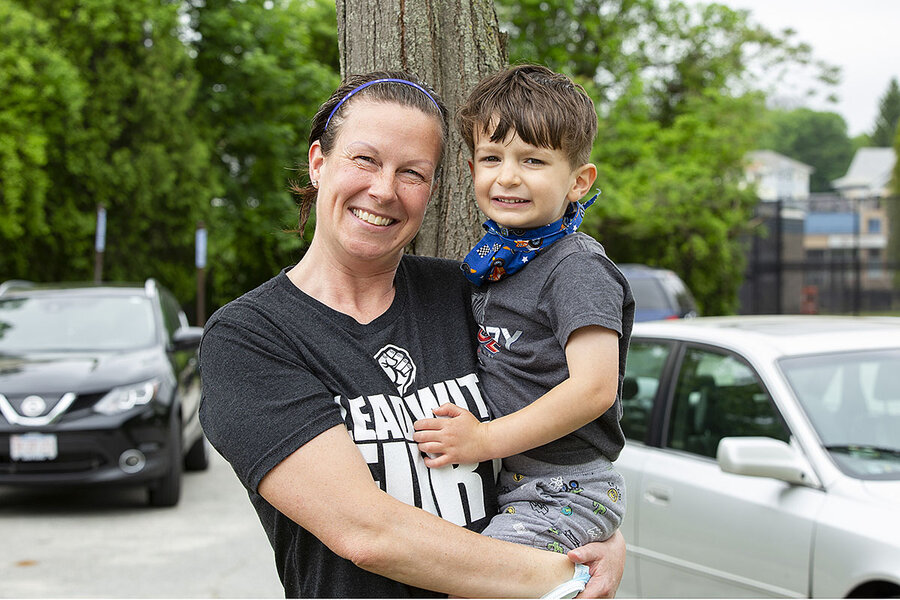
The Center on Reinventing Public Education recently analyzed summer school plans for 100 public school districts across the U.S. and found uneven programming, with 61% of those districts offering summer school.
What is offered this summer should be based on student needs, which will vary by how much support schools and families could provide this spring, says Douglas Harris, a professor at Tulane University in New Orleans who researches the economics of education.
“The idea of the achievement gap widening in this scenario is most certainly the case,” he says. “The key is figuring out what each student needs and getting them what they need to get back on track.”
Summer can also offer other opportunities, say educators. While internet access offers challenges, online learning can open the door to more options and include “community-based expertise,” writes Thomas Del Prete, director of the Adam Institute for Urban Teaching and School Practice at Clark University in Worcester, in an email to the Monitor.
“We have an opportunity to reimagine and broaden our thinking on what learning can look like in the summer (and beyond) and who can participate. We might start this summer by thinking how to create opportunities for learning for a broader range of students, not just for purposes of remedial learning, for some form of enrichment, or to get a head start on reading for the school year,” he writes.
He suggests activities curated by teachers including online bookclubs and museum tours, and online or phone interviews for oral history projects.
In Los Angeles, summer school is open for the first time to all students online, and the Los Angeles Unified School District is pairing with film studios and sports teams for enrichment classes. Elsewhere, in Illinois, the governor signed an executive order allowing in-person summer school. Massachusetts Education Commissioner Jeffrey Riley released guidance last week allowing in-person instruction for groups of 10 students or fewer. The guidelines also said remote learning might be the “most feasible and safest” option for many districts.
One example: Worcester
In Worcester, all summer school will be conducted online, and community groups are eager to form partnerships to enhance programming. But detailed summer school plans have been slow to develop and there are concerns from the community and educators about being able to reach students who most need help.
“There’s an opportunity to transform the way we do the business of teaching and learning in this moment,” starting with summer school, says Jennifer Davis Carey, executive director of the Worcester Education Collaborative, a nonprofit community group in the city of about 186,000 people. “We have to make sure we capture that opportunity.”

Located about an hour west of Boston and home to a dozen colleges, several museums, and spacious parks, Worcester has experienced rapid growth in the past few years. The city’s school district, with about 25,000 pupils, has higher rates of economically disadvantaged students and students of color than the state average. The district has earned some accolades, including former President Barack Obama calling Worcester Technical High School a model for the nation.
Maureen Binienda, superintendent of Worcester Public Schools, says the district plans to expand summer school to all students in grades 2 through 6 for the first time. The district will also offer its typical programs for middle and high school credit recovery, English language learners, and special education students. Most Worcester summer school programs will begin on June 17, five days after the school year ends.
Ms. Binienda says she’s hoping that the number of kids participating in summer school will increase this year with the expanded elementary school programs, but “we’ll wait to see if parents are exhausted.” She says the district doesn’t know the format yet of fall reopening, but summer school could help if it includes remote elements. “The more you do online learning, the better you get.”
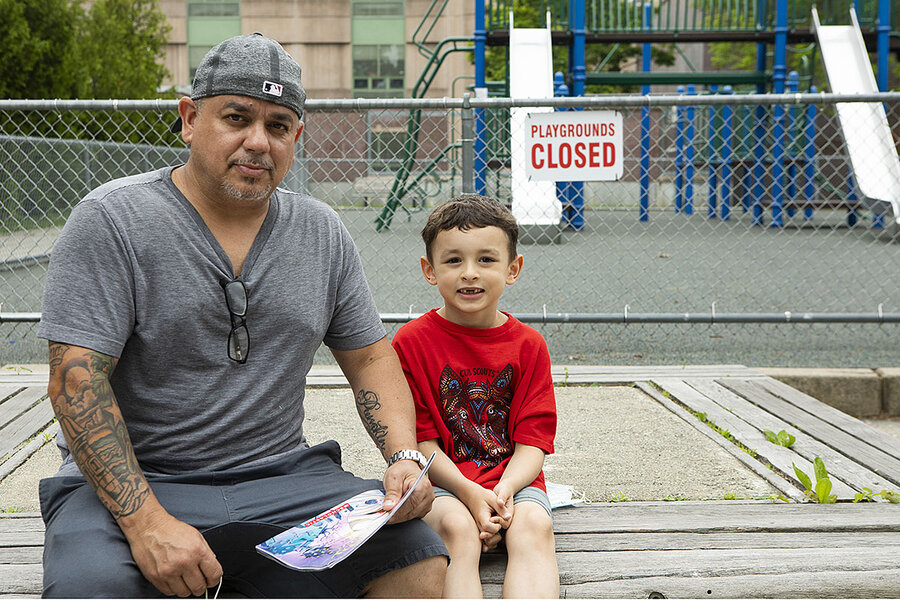
On a recent morning, Jose Lehardy and his step-grandson pause outside Gates Lane to pick up a meal and talk about school. They say they’re interested in more summer activities from the school. Mr. Lehardy praises remote learning so far for keeping his 7-year-old grandson Ryan headed in the “right direction.” The second grader says he likes writing a letter to his teacher every day and practicing spelling.
Ms. Carey, of the Worcester Education Collaborative, says she’s working closely with community groups and cultural organizations such as the Boys & Girls Club, the Worcester Art Museum, and EcoTarium, a local children’s science museum, to create modules for students to complement their schooling this summer and throughout the year.
“We have to come together as a community and essentially create learning [opportunities] anytime, anyplace,” she says.
A key challenge for Worcester Public Schools, like other districts around the U.S., is lack of internet connectivity and technology access for students. The district has distributed 1,400 Chromebooks, giving all families one laptop for every two children. Superintendent Binienda says the district is 6,000 laptops away from its goal of one device for every student, and plans to spend some of the funds it receives from the federal CARES Act on Chromebooks and internet hot spots. The district was still distributing laptops to students in late May, and families can keep them for the summer.
With the switch to remote learning has come a higher level of parent involvement with the education of students, says Ms. Binienda, who hopes that continues this summer and beyond.
That may be the case for Jonathan Echevarria, a single father in Worcester. He says it’s been a challenge to oversee schoolwork, but he’s learned a lot about his son Jaevell and his kindergarten education that he didn’t know before. He may even continue with a special online summer school program offered for younger students.
“I see his real potential and personality now,” Mr. Echevarria says.
Editor’s note: As a public service, all our coronavirus coverage is free. No paywall.

Listen
Could the coronavirus change the way we look for love? (audio)
As it turns out, reducing human contact in our day-to-day lives transforms how we connect. Is it even possible to comfortably date today? For many, the answer is yes. It just takes a bit of creativity.
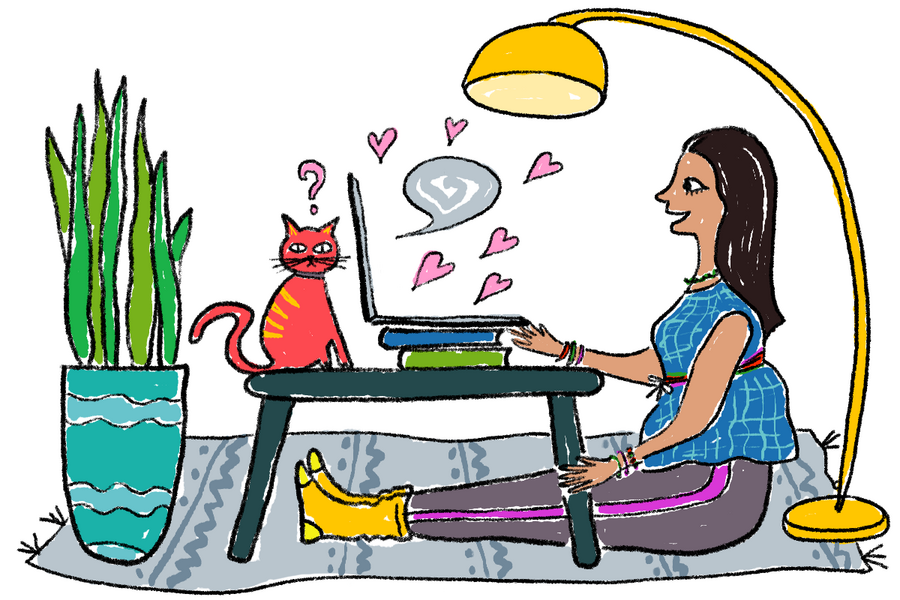
The coronavirus pandemic has turned lives upside down, with stay-at-home orders shifting relationships with family and friends in major ways. But what has this meant for individuals looking for love?
Many men and women across the world are continuing to date during COVID-19 – even if that means coming up with creative solutions to meeting new people, like going on Zoom dates or watching movies at the same time in two separate apartments.
The shift away from dining in restaurants or going out has been frustrating, but those in the thick of it are finding things they like about this new approach to dating. There’s more time spent chatting on the phone, and less opportunity to “peacock” and show off. For some, it’s as if romance is getting a throwback to the style of Jane Austen novels, with heartfelt correspondence and a slower pace.
Although there’s a sense of anticipation and hope for the day dinner and a movie – in person and in public – is on the table once again, dating is getting a reboot. – Whitney Eulich, Latin America editor, and Jessica Mendoza, multimedia reporter
Note: This audio story was designed to be heard. We strongly encourage you to experience it with your ears, but we understand that is not an option for everybody. For those who are unable to listen, we have provided a transcript of the story. (If you’re reading this off our website and don’t see an audio player, click here to access the audio player.)
Could the coronavirus change the way we look for love?
Other headline stories we’re watching
(Get live updates throughout the day.)The Monitor's View
Nations that plant roots of peace
- Quick Read
- Deep Read ( 2 Min. )
-
By the Monitor's Editorial Board
The latest Global Peace Index, which tries to measure levels of “peacefulness,” put Afghanistan at the bottom while Iceland is the most peaceful. The index also finds a widening gap between the least and most peaceful countries. Perhaps the biggest surprise is that a particular region has shown the greatest improvement: the former Soviet states in Eurasia. Over the past four years, eight of the 12 countries have steadily become more peaceful. And the definite leader is Armenia, a small landlocked nation of nearly 3 million.
Its progress is largely due to a nonviolent “velvet” revolution in 2018 that restored its democracy and then elected a reform-minded journalist, Nikol Pashinyan, as prime minister. Mr. Pashinyan does not see security through the lens of the military. Rather it lies in cracking down on corruption, improving rule of law with an independent judiciary, building up local self-governance, and diversifying Armenia’s economy and trade ties.
Peace is a positive force, one that can be measured. When an entire nation like Armenia rises up to embrace it, the world takes note.
Nations that plant roots of peace
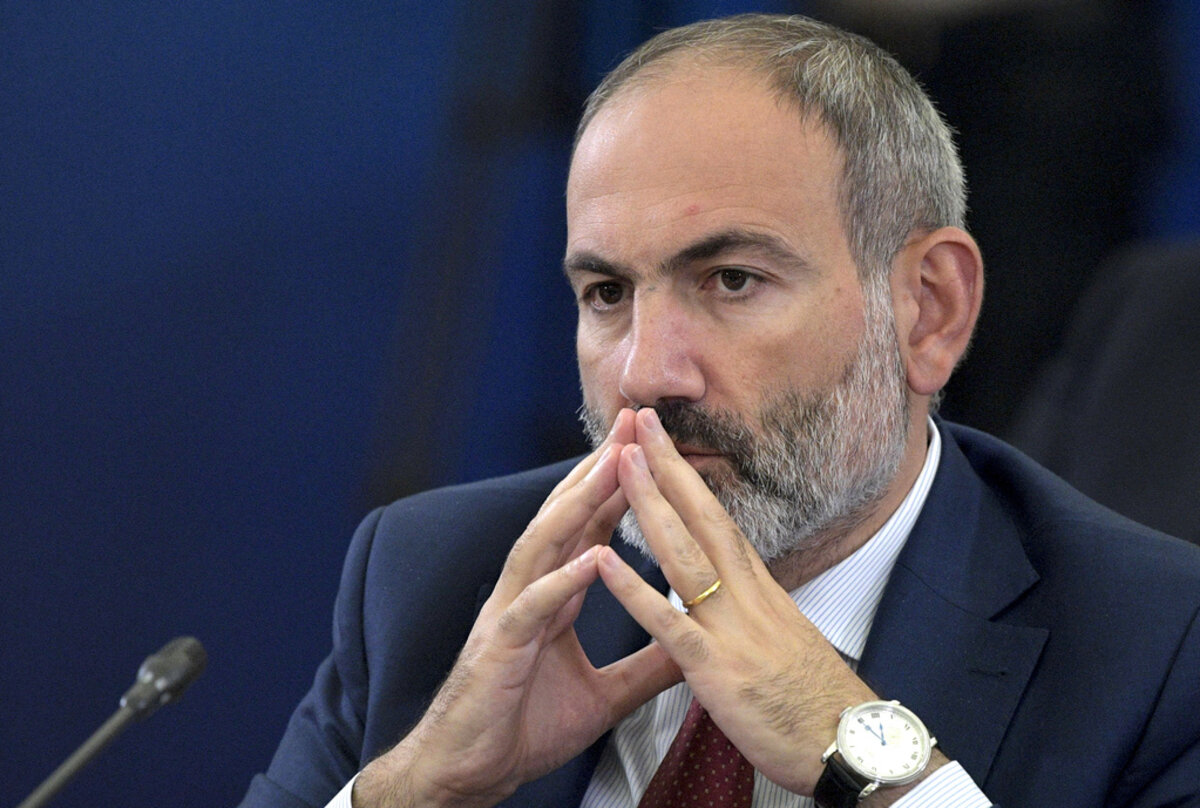
More than half the world’s countries have a lower homicide rate than 12 years ago. More than half have cut military spending. In the past five years, deaths from terrorism are down by half. Yet riots and general strikes have been skyrocketing worldwide. Last year, 96 countries saw at least one violent protest.
These are just a few of the statistics from the latest Global Peace Index, which tries to measure levels of “peacefulness” based on 23 indicators. The latest findings put Afghanistan at the bottom while Iceland is the most peaceful. This year’s index also finds a slight deterioration in peace along with a widening gap between the least and most peaceful countries.
Perhaps the biggest surprise in this study by the Institute for Economics and Peace is that one particular region has shown the greatest improvement: the former Soviet states in Eurasia. Over the past four years, eight of the 12 countries have steadily become more peaceful. And the definite leader in peacemaking is Armenia, a small landlocked nation of nearly 3 million that shot up 15 places in the index to 99.
Armenia’s progress is largely due to a nonviolent “velvet” revolution in 2018 that restored its democracy and then elected a reform-minded journalist, Nikol Pashinyan, as prime minister. He is the type of new leader who says things like “I do believe in our citizens’ ability to turn mountains upside down with their behavior.” (Ethiopia’s leader is another example.)
Yet his real talent has been in expanding and redefining the concept of security. Mr. Pashinyan does not see security through the lens of the military. Rather it lies in cracking down on corruption, improving rule of law with an independent judiciary, building up local self-governance, and diversifying Armenia’s economy and trade ties. One telling indicator: the country’s incarceration rate has fallen by a third since the revolution.
He has also quelled a violent conflict with Azerbaijan (which itself has improved in peacefulness). The two neighbors fought their last war in 2016 over contending claims to the Nagorno-Karabakh enclave and seven surrounding districts. Negotiations that began soon after Mr. Pashinyan rose to power have ended the violence and raised hopes of a peaceful resolution.
Mr. Pashinyan attributes this progress to a breakthrough in “the collective consciousness of our people” during the 2018 revolution. The Eurasia region often has leaders who see democracy as a threat to national security. Yet in Armenia, a revival of democracy has improved its security. It has also boosted the country in two other global rankings – levels of freedom and in curbing corruption.
Peace is a positive force, one that can be measured. When an entire nation like Armenia rises up to embrace it, the world takes note. Another mountain has been moved.

A Christian Science Perspective
Each weekday, the Monitor includes one clearly labeled religious article offering spiritual insight on contemporary issues, including the news. The publication – in its various forms – is produced for anyone who cares about the progress of the human endeavor around the world and seeks news reported with compassion, intelligence, and an essentially constructive lens. For many, that caring has religious roots. For many, it does not. The Monitor has always embraced both audiences. The Monitor is owned by a church – The First Church of Christ, Scientist, in Boston – whose founder was concerned with both the state of the world and the quality of available news.
Finding a joy that can’t be masked
- Quick Read
- Read or Listen ( 3 Min. )
-
By Amy Humphries
In a world where face coverings have become ubiquitous, it can sometimes feel as if we’re losing part of our identity. But no mask can keep us from expressing our God-given joy and individuality.
Finding a joy that can’t be masked
Our local government, like so many others, issued a directive requiring the wearing of face masks in most situations due to the coronavirus pandemic. I appreciated the caring intention behind the rule and wanted to be law-abiding, but I also feared that an ability to let one’s individual light shine was being taken away – that people’s unique identities were being replaced by faceless, soulless drones.
I struggled for quite a while with this situation. I was spinning my wheels and getting nowhere. And on top of it all, I developed uncomfortable, persistent jaw tension.
So I wholeheartedly prayed to God. I knew from experience that when we’re looking for healing or a sense of peace, striving to see out from God’s vantage point rather than from a limited, mortal view is extremely helpful.
I thought of how, in the Bible, a man named Joseph found a way to let his light shine even from the depths of prison. Eventually he ruled over the land.
And how Jesus gave his enemies his body, but that didn’t give away his eternal, spiritual individuality. Even his crucifixion and burial in a tomb didn’t stop him from demonstrating, through his resurrection, everlasting Life.
In the textbook of Christian Science, Mary Baker Eddy states, “Identity is the reflection of Spirit, the reflection in multifarious forms of the living Principle, Love” (“Science and Health with Key to the Scriptures,” p. 477). The true identity of all of us is not material, but spiritual – the reflection of divine Spirit, God. Science and Health explains, “This scientific sense of being, forsaking matter for Spirit, by no means suggests man’s absorption into Deity and the loss of his identity, but confers upon man enlarged individuality, a wider sphere of thought and action, a more expansive love, a higher and more permanent peace” (p. 265).
I realized that no mask could ever take my ability to express qualities of divine Life, Truth, Soul, Spirit, Mind, as they come from God. God is the one true Mind, the source of our ability to think and act productively. God is infinite Soul, impelling our ability to express our true nature in individual, unique ways. And since God is eternal, and we are His loved and flawless spiritual image, or expression, these qualities are inherent in our being. They can never be taken from us.
Catching this glimpse of my spiritual, untouchable individuality lifted much of my frustration about the mask requirements, but I still didn’t feel totally settled about the situation.
Then I thought of a section in the “Manual of The Mother Church” by Mary Baker Eddy called “God’s Requirement.” This passage, which people of all backgrounds can relate to, states, “God requires wisdom, economy, and brotherly love to characterize all the proceedings of the members of The Mother Church, The First Church of Christ, Scientist” (p. 77).
As I pondered the idea of “God’s requirement” including “brotherly love,” an idea came to me. It was a unique way to express my God-given joy and individuality freely, while being law-abiding and loving to others around me by wearing a mask. The idea was to have an image of my smiling face printed on a mask.
I felt elated and free! I felt so deeply divine Love, God, being reflected through loving thoughts and actions. The angst and jaw tension disappeared.
So even if we’re wearing a mask, we can know that our individuality and uniqueness come from God, and nothing and no one can stop us from expressing joy and brotherly love. They are eternally visible! As Jesus promises, “No one will take away your joy” (John 16:22, New International Version).
I still look forward to the day when masks will not be part of everyday life. But even before then, I’ll be living my inner joy, warmth, and peace – and you can too!
Editor’s note: As a public service, all the Monitor’s coronavirus coverage is free, including articles from this column. There’s also a special free section of JSH-Online.com on a healing response to the global pandemic. There is no paywall for any of this coverage.

A message of love
Voting as endurance test
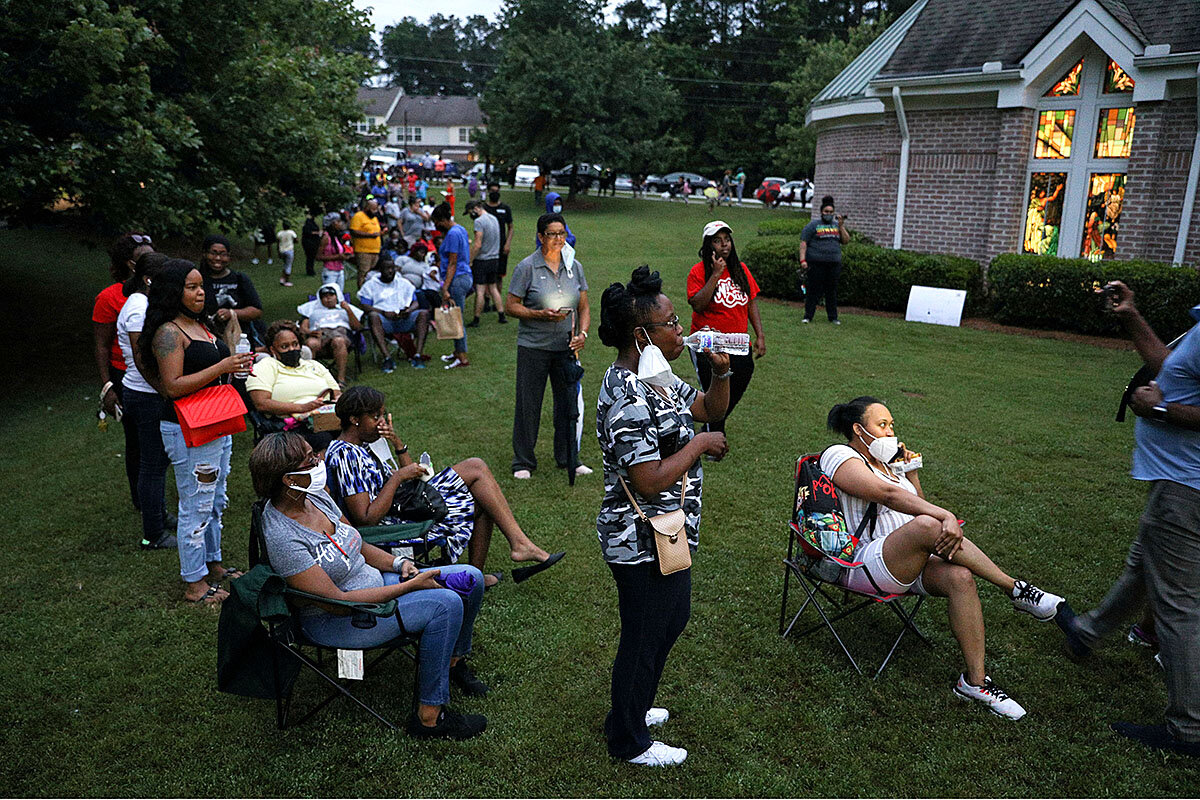
A look ahead
Thank you for joining us today. Please come back tomorrow when Martin Kuz looks at how Minneapolis is trying to heal after the death of George Floyd, and its hopes to become a beacon of change for the country.



